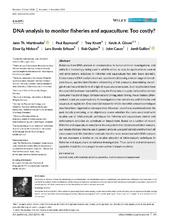| dc.contributor.author | Martinsohn, Jann Th. | |
| dc.contributor.author | Raymond, Paul | |
| dc.contributor.author | Knott, Trey | |
| dc.contributor.author | Glover, Kevin | |
| dc.contributor.author | Nielsen, Einar Eg | |
| dc.contributor.author | Eriksen, Lars Bonde | |
| dc.contributor.author | Ogden, Rob | |
| dc.contributor.author | Casey, John | |
| dc.contributor.author | Guillén, Jordi | |
| dc.date.accessioned | 2019-06-26T12:42:49Z | |
| dc.date.available | 2019-06-26T12:42:49Z | |
| dc.date.issued | 2019-03 | |
| dc.Published | Martinsohn JT, Raymond, Knott, Glover KA, Nielsen EE, Eriksen, Ogden R, Casey J, Guillén J. DNA-analysis to monitor fisheries and aquaculture: Too costly?. Fish and Fisheries. 2019;20(2):391-401 | eng |
| dc.identifier.issn | 1467-2960 | en_US |
| dc.identifier.issn | 1467-2979 | en_US |
| dc.identifier.uri | http://hdl.handle.net/1956/20457 | |
| dc.description.abstract | Evidence from DNA‐analysis is commonplace in human criminal investigations, and while it is increasingly being used in wildlife crime, to date, its application to control and enforcement activities in fisheries and aquaculture has only been sporadic. Contemporary DNA‐analysis tools are capable of addressing a broad range of compliance issues, species identification, mislabelling of fish products, determining the origin of catches and the farm of origin of aquaculture escapees. Such applications have the potential to ensure traceability along the fish product supply chain and to combat consumer fraud and Illegal, Unreported and Unregulated fishing. Nevertheless, DNA‐analysis is not yet used routinely in investigations into compliance with fisheries and aquaculture legislation. One potential reason for this is that DNA‐analysis techniques may have been regarded as too expensive. However, costs have plummeted over the past decade prompting us to objectively assess whether the costs associated with routine use of DNA‐analysis techniques for fisheries and aquaculture control and enforcement activities do constitute an impediment. Based on a number of recent fisheries and aquaculture compliance investigations that incorporated DNA‐analysis, our results indicate that the use of genetic analysis was justified and worthwhile in all cases examined. We therefore conclude that the costs associated with DNA‐analysis do not represent a barrier to the routine adoption of DNA‐analysis techniques in fisheries and aquaculture compliance investigations. Thus, control and enforcement agencies should be encouraged to use such techniques routinely. | en_US |
| dc.language.iso | eng | eng |
| dc.publisher | Wiley | en_US |
| dc.rights | Attribution CC BY | eng |
| dc.rights.uri | http://creativecommons.org/licenses/by/4.0/ | eng |
| dc.subject | control | eng |
| dc.subject | costs | eng |
| dc.subject | enforcement | eng |
| dc.subject | Genetics | eng |
| dc.subject | genomics | eng |
| dc.subject | marine resource management | eng |
| dc.title | DNA-analysis to monitor fisheries and aquaculture: Too costly? | en_US |
| dc.type | Peer reviewed | |
| dc.type | Journal article | |
| dc.date.updated | 2019-03-06T10:15:38Z | |
| dc.description.version | publishedVersion | en_US |
| dc.rights.holder | Copyright 2018 The Author(s) | en_US |
| dc.identifier.doi | https://doi.org/10.1111/faf.12343 | |
| dc.identifier.cristin | 1682431 | |
| dc.source.journal | Fish and Fisheries | |
| dc.relation.project | EC/FP7: 212399 | |

